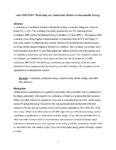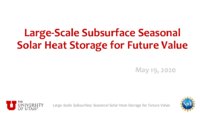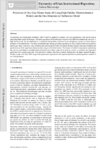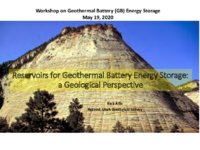|
|
Creator | Title | Description | Subject | Date |
| 26 |
 |
Pershing, David W. | Influence of fuel composition and flame temperature on the formation of thermal and fuel NOx in residual oil flames | A 900 kw model package boiler and a 20 kw laboratory tunnel furnace were used to study fuel and thermal NO, formation during heavy oil combustion. Package boiler results indicated that atomizer design, spray/ flow field interactions, and fuel composition were significant, dependent parameters. These... | Residual oil flames | 1979 |
| 27 |
 |
Pershing, David W.; Wendt, Jost O. L. | Investigation of first- and second-stage variables on control of NOx emissions using staged combustion in a pulverized coal wall-fired furnace | Recent tests on an EPA 1- to 1.5 x 106 Btu/hr pilot-scale pulverized coal furnace show that N0X emissions of 100 ppm to 150 ppm (zero percent 02) are achievable with the use of two-stage combustion. Comparable N0X emission levels were obtained with three different coal types fired in either the sing... | NOx; Carbon monoxide; Emissions | 1979 |
| 28 |
 |
Eddings, Eric G. | Joint NSF-NSFC Workshop on Combustion Related to Sustainable Energy | A workshop on Combustion Related to Sustainable Energy was held in Hangzhou, China on March 10-12, 2014. The workshop was jointly sponsored by the U.S. National Science Foundation (NSF) and by the National Science Foundation of China (NSFC). The purpose of the workshop was to bring together a limite... | Combustion, sustainable energy, research needs, climate change, renewable fuel, efficiency, Workshop China | 2016 |
| 29 |
 |
McLennan, John | Large-scale subsurface seasonal heat storage for future value | I too extend my welcome. And, I extend thanks to the NSF for the support of this research at the Univ. of Utah. The concept of storing heat in the ground is certainly not new. Many, many cases have investigated heat to be stored underground. Getting the heat underground is somewhat of a problem, but... | | 2020-05-19 |
| 30 |
 |
Pershing, David W. | Mechanisms of NOx formation and control: alternative and petroleum-derived liquid fuels | Petroleum-, coal- and shale-derived liquid fuels were burned in a downfired tunnel furnace to assess the impact of fuel properties on the formation and control of NOx emissions. A nitrogen-free oxidant mixture (Ar, C02 , 02) was used to isolate fuel NOx formation. Under excess air conditions fuel N... | Exhaust emissions; Alternative fuels; Petroleum-derived liquid fuels | 1981 |
| 31 |
 |
Eddings, Eric G.; Sarofim, Adel F. | Modeling benzene and naphthalene formation in a premixed propylene flame | The Utah Surrogate Mechanism was used to model a fuel-rich, non-sooting premixed laminar flame of propylene at 5000 Pa with an equivalence ratio of 2.32. The simulation results were found to be satisfactory in comparison with the experimental data. For example, the measured concentration profiles of... | Utah Surrogate Mechanism; Propylene; Combustion modeling; Benzene formation; Naphthalene formation | 2005 |
| 32 |
 |
Lighty, Joann; Sarofim, Adel F.; Eddings, Eric G. | Modeling the coagulation of charged particles | One important mechanism in the growth of soot particles is to understand the role of particle charge in the coagulation of the particles. A previously developed model has been extended to include the coagulation of charged particles. The model includes neutral particles and charged particles (up to ... | Charged particles; Flame ionization; Modeling | 2004 |
| 33 |
 |
Eddings, Eric | Modified CPD Model for Coal Devolatilization at UCTT Conditions | To study coal pyrolysis behavior at underground coal thermal treatment (UCTT) conditions, a modified CPD (M-CPD) model was developed and evaluated using two scales of experiments as well as two different coals, Utah Sufco and Illinois #6. Compared with the original CPD model, three major aspects wer... | Coal; pyrolysis; modeling; underground heating | 2019 |
| 34 |
 |
Sarofim, Adel F.; Eddings, Eric G. | Muiltifunctional fuel additives for reduced jet particlate emissions | Using Government drawings, specifications, or other data included in this document for any purpose other than Government procurement does not in any way obligate the U.S. Government. The fact that the Government formulated or supplied the drawings, specifications, or other data does not license the ... | | 2006 |
| 35 |
 |
Eddings, Eric G. | NOx emissions from intermediate-temperature combustion of steel-industry by-product gases | A study of NOx emissions from the combustion of coke-oven gas and blast-furnace gas (steel industry by-product gases) was undertaken using detailed kinetic modeling to elucidate the pathways for NOx formation. The study was performed at the intermediate temperatures (1200-1400K) and 1 atm, which rep... | | 2004 |
| 36 |
 |
Sarofim, Adel F. | Numerical combustion of aviation fuel part I: a cross-model comparison of n-heptane premixed flame | Four different n-heptane mechanisms were used to simulate a fuel rich n-heptane premixed flame and their results were compared with experimental measurements. In addition to discussion of the numerical performance of each mechanism, flux analysis coupled with the atomic distribution technique was us... | Aviation fuel; n-heptane; Premixed flame | 2003 |
| 37 |
 |
Pershing, David W.; Slaughter, David Michael | Parameters influencing the evolution and oxidation of sulfur in suspension phase coal combustion | Stoker coal-fired boiler furnaces are significant in terms of coal consumption and environmental impact; however, they have received relatively little research attention. This paper describes the results of a two-year study on the formation of sulfur oxides in the suspension phase of a coal-fired s... | Stoker coal-fired furnaces | 1983 |
| 38 |
 |
Sutherland, James Clayton | Prediction of oxy-coal flame stand-off using high-fidelity thermochemical models and the one-dimensional turbulence model | An Eulerian one-dimensional turbulence (ODT) model is applied to simulate oxy-coal combustion, with specific aim at predicting flame stand-o distances. Detailed gas-phase chemical kinetics based on the GRI3.0 mechanism are utilized. A high-fidelity model for devolatilization is considered that predi... | | 2014-01-01 |
| 39 |
 |
Eddings, Eric G.; Sarofim, Adel F.; Pershing, David W. | Production of nitrogen oxide during char oxidation at pulverized coal combustion conditions | More stringent regulations for NOx control in pulverized coal combustors have made the scientific community focus on sources of emissions that were traditionally considered less relevant to the overall NOx production. The oxidation to NO of the nitrogen that is organically bound to the char is one o... | | 2001 |
| 40 |
 |
Pershing, David W.; Wendt, Jost O. L. | Pulverized coal combustion: NOx formation mechanisms under fuel rich and staged combustion conditions | A 2 Kg/h pulverized fuel one dimensional flame combustor was used to determine time resolved NO profiles under fuel rich and staged combustion conditions. Seven solid fuels, including two coal chars, were investigated. Results show that at all fuel rich conditions NO is formed rapidly and then is ... | Flame; Composition; Reaction | 1979 |
| 41 |
 |
Pershing, David W.; Wendt, Jost O. L. | Pulverized coal combustion: the influence of flame temperature and coal composition on thermal and fuel NOx | A laboratory combustor was used to investigate the factors that influence the conversion of fuel nitrogen in coal during coal combustion. Fuel NO was isolated by experimentation utilizing Argon / Oxygen / Carbon Dioxide mixtures as the oxidant, and care was taken to compare cases with air at matche... | Fuel nitrogen; Flame temperature; Coal composition | 1977 |
| 42 |
 |
Smith, Philip J. | Reduced-order PCA models for chemical reacting flows | One of the most challenging aspects of turbulent combustion research is the development of reduced-order combustion models which can accurately reproduce the physics of the real system. The identification and utilization of the low dimensional manifolds in these system is paramount to understand and... | | 2014-01-01 |
| 43 |
 |
Allis, Rick | Reservoirs for Geothermal Battery Energy Report: a geological perspective | Workshop presentation | | 2020-05-18 |
| 44 |
 |
Ring, Terry Arthur | Room temperature co-precipitation synthesis of magnetite nanoparticles in a large pH window with different bases | Magnetite nanoparticles (Fe3O4) represent the most promising materials in medical applications. To favor high-drug or enzyme loading on the nanoparticles, they are incorporated into mesoporous materials to form a hybrid support with the consequent reduction of magnetization saturation. The direct sy... | | 2013-01-01 |
| 45 |
 |
Eddings, Eric G.; Sarofim, Adel F.; Pugmire, Ronald J. | Selection of surrogates for jet fuels | Abstract: A. detailed characterisation of JP fuels is provided based on literature data for the average of 55 worldwide and 4 US Jet-A fuels. These are complemented by NMR analysis of a JP-8 that provides the fractions of the carbon in the fuel that are present as protonated, bridgehead, and non-sub... | Jet propulsion fuel; Surrogates; Simulations | 2008 |
| 46 |
 |
Sarofim, Adel F. | Simulation of soot formation using particle dynamics with one dimensional nucleation mode | Two soot formation models using particle dynamics with one-dimensional nucleation mode directly coupled with gas phase chemistry are tested on three ethylene and three methane laminar premixed flames. These models demonstrate strength in the prediction of concentration profiles of major combustion p... | Soot formation models; Particle dynamics; One dimensional nucleation mode; Combustion chemistry | 2004 |
| 47 |
 |
Smith, Philip J. | Soot in combustion simulations | Soot is the dominant source of radiative heat transfer from most practical flames. A review is presented of historical, empirical modelling approaches for estimating heat flux from fires and flames. These historical methods have drawn on empiricism to address the role of soot while seeking methods f... | Large eddy simulation; LES; Combustion simulation; Radiative heat transfer; Pool fires | 2005 |
| 48 |
 |
Eddings, Eric G.; Spinti, Jennifer C.; Smith, Philip J. | Soot volume fraction from extinction in JP-8 and heptane pool fires | Total extinction measurements from a multiple beam experiment using a 10mW laser diode are presented and compared to calculate soot volume fraction in heavily sooting pool fires from a 150 mm diameter pan of Jet Propulsion fuel 8 (JP-8) and heptane. Trends in attenuation are critiqued for the t... | Pool fires; Jet propulsion fuel | 2005 |
| 49 |
 |
Eddings, Eric G.; Smith, Philip J. | Soot volume fraction from extinction in JP-8 and heptane pool fires | Total extinction measurements from a multiple beam experiment using a 10mW laser diode are presented and compared to calculate soot volume fraction in heavily sooting pool fires from a 150 mm diameter pan of Jet Propulsion fuel 8 (JP-8) and heptane. Trends in attenuation are critiqued for the t... | Soot volume fraction; Heptane pool fires; JP-8 pool fires; Heavily sooting pool fires; Laser diagnostics | 2005 |
| 50 |
 |
Veranth, John M.; Pershing, David W.; Sarofim, Adel F. | Sources of unburned carbon in the fly ash produced from low-NOx pulverized coal combustion | The unburned carbon in the fly ash produced from low-NOx pulverized coal combustion is shown to consist of a mixture of soot and coal char. The soot was identified by the presence of chains or aggregates of 10-50-nm-diameter primary particles in electron microscope images of both laboratory sample... | Unburned carbon; Char | 1998 |

























